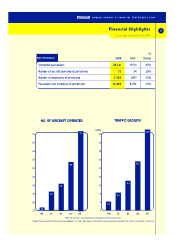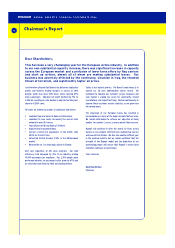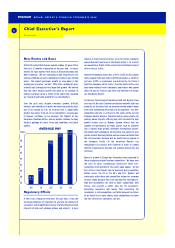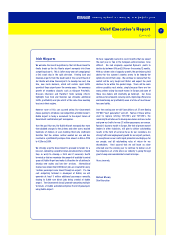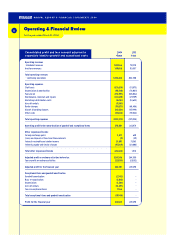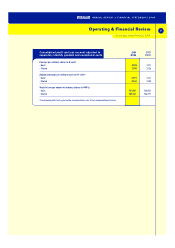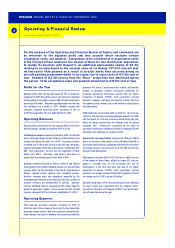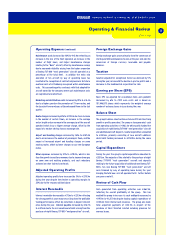Ryanair 2004 Annual Report Download - page 13
Download and view the complete annual report
Please find page 13 of the 2004 Ryanair annual report below. You can navigate through the pages in the report by either clicking on the pages listed below, or by using the keyword search tool below to find specific information within the annual report.
Recruitment and Promotion
During the year 191 of our people were promoted internally
within the group, and Ryanair employed on average an extra
542 staff during the year compared to the preceeding 12
months.
Safety
Safety in the airline remains an absolute priority. This is
Ryanair’s 20th year of safe operations. Ryanair has extensive
safety training programmes to ensure the recruitment of
s u i tably qualified pilots and mainte n a n ce personnel. In
addition, the group operates and maintains all of its aircraft in
a cco rd a n ce with the highest Eu ro p ean Aviation Indust ry
Standards which are regulated by the Irish Aviation Authority.
At each Board Meeting a report prepared by the Air Safety
Committee is circulated in advance and is reviewed by the
Board. The Safety Committee, comprises Michael Horgan
(chairperson), a director of the Board, the Director of Flight
and Ground Operations, the Chief Pilot, the Flight Safety
Officer and the Director of Engineering, and this committee
meets on a quarterly basis and reports directly to the Board of
D i re c to rs. The Flight Sa fety Offi c er is responsible fo r
monitoring and controlling all aircraft related safety issues.
The group also has a Health and Sa fety Offi cer who is
responsible for overseeing safety in all other areas. The group
co n t i n u es to opera te ex te n s i ve training and sa fe ty
p ro g ra m m es to ensure the health and sa fety of all its
passengers and employees.
Treasury Policy, Fuel, Currency and
Interest Risk Management
The Audit Co m m i ttee of the Bo a rd of Dire c to r s has
responsibility for setting the treasury policies and objectives
of the group which include controls over procedures used to
manage the main financial risks arising from the group’s
operationswhich comprise commodity price, foreign exchange
and interest rate risks. The group uses financial instruments
to manage ex p os u res arising from these risks. Th es e
instruments include borrowings, cash and liquid resources and
d e r i va t i ves (principally jet fuel deriva t i ves, i n te rest ra te
swa ps, fo r wa rd fo reign exchange co n t ra c ts and fo r wa rd
starting interest rate swaps). It is group policy that no
speculative trading in financial instruments shall take place.
The group’s historical fuel risk managment policy has been to
hedge between 70% and 90% of the forecasted rolling annual
volumes required to ensure that the future cost per gallon of
fuel is locked in. This policy had been adopted to prevent the
group being exposed, in the short term, to adverse movements
in world jet fuel prices. Occasionally however, when deemed to
be in the best interests of the group, itmay deviate from this
policy owing to commercial necessity. At March 31, 2004 the
group had hedged its fuel exposures to the end of September
2004 and is largely unhedged therea ft e r. The gro u p
anticipates that overthemedium termfuel prices will fall and
therefore it wouldbe unwise to commit to purchase fuel at the
current high forward rates. Further details of year end fuel
derivatives are set out in note 17.
Fo reign cu r re n cy risk in relation to the gro u p’s tra d i n g
operations largely arises in relation to non-euro currencies.
These currencies are primarily sterling pounds and US dollar.
The group manages this risk by matching sterling revenues
against sterling costs. Any unmatched sterling revenues are
used to fund forward foreign exchange contracts to hedge US
dollar cu r ren cy ex p os u res that arise in relation to fuel,
maintenance, aviation insurance, and capital expenditure costs
- including aircraft related payments to Boeing.
The group’s objective for interest rate risk management is to
re d u ce inte rest risk through a combination of fi n a n c i a l
instruments which lock in interest rates on debt and by
matching a proportion of floating rate assets with floating rate
liabilities. In addition, the group aims to achieve the best
available return on long-term investments of surplus cash -
subject to credit risk and liquidity constraints. Credit risk is
managed by limiting the aggregate amount and duration of
exposure to any one counterparty based on third party market
based ratings.
In line with the above interest rate risk management strategy
the group has entered into a series of forward starting interest
rate swap agreements to manage interest rate risk in relation
to the financing of new Boeing 737-800 “next generation”
aircraft. The objective of these swap agreements is to hedge
the group’s exposure to movements in fixed interest rates in
relation to forecasted draw-downs of debt. Additionally the
group has entered into floating rate financing for certain
aircraft which is matched with floating rate deposits. The
group has also entered into a series of interest rate swaps to
hedge against fluctuations in interest rates for certain floating
rate financing arrangements. Cash deposits have been set
aside as collateral (subject to an agreed capped amount of
20 0.0 m) to mitigate ce rt a i n co u n te r p a rty risk of
fl uctuations on long-term deriva t i v e and fi n a n c i n g
a r ra n g e m e n ts ( “ rest r i c ted ca s h”). At March 31, 20 0 4
restricted cash amounted to 200.0m (2003: 120.9m).
Additional numerical information on these swaps and on other
derivatives held by the group is set out in notes 15 to 18 of the
financial statements.
(Continued)
Operating & Financial Review 13
A N N U A L R E P O RT & F I N A N C I A L S T A T E M E N T S 2 0 0 4


